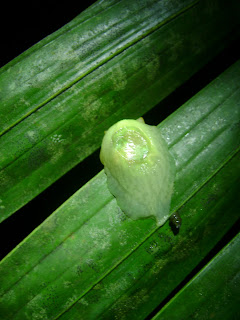






Tuesday, January 18, 2011
Today was our first official day of working on our plots, so far so good. I feel a lot better a
b
out my identification skills, but there are literally hundreds of species we still don’t know yet. Overall it was a good day; we got through about three plots, I saw some cool shelf fungus and I got to go running with Sasha and Quentin. I was told not to ever go running alone up here; there are lots of robberies and it isn’t safe unfortunately. I watched 30-Rock for the first time this evening – it was hilarious.
Another good day in the field with beautiful weather and learned more seedlings! We got back to the station around 4:00pm, and had our first seminar. Barbara Richardson, who studies microarthropod diversity in Carribean forests and bromeliads talked for about an hour or so.
There are four types of forest her in Puerto Rico: Palm forest exists in the wettest areas, and Palms here are found irrespective of elevation, Dwarf/Elvin or cloud forest which receives about 5 m of rain per year and is characterized by anoxic soils, low net primary production, and exists above 900 m elevation. Most of the plants in this forest are smaller (dwarf forest), and have cortaceous leaves; they have a thick, waxy covering with lots of xylem tissues and schlerinchema that protects that photosynthetic tissue. In the elfin forest, bromeliads even cover the forest floor. Palo Colorado is the t
hird type of forest, which is subtropical wet and exists between 600 – 900 m asl (abo
ve sea level). This forest is characterized by an open canopy and high structural diversity. And finally, the Tabonuco forest (where I am working) exists at less than 600 m elevation and is characterized by a closed canopy and there are few bromeliads in the lower canopy. Most of the trees here have a compound leaf structure with thin leaves.
Barbara explained that there are two main types of bromeliads: air plants that get moisture from the surrounding air and air particles, and tank bromeliads that have an expanded leaf base that are wrapped aro
und each other and gather detritus. In addition, Bromeliads are only found in the Americas. She specifically studies tank bromeliads which are useful to study because they run parallel with the forest ecosystem – in terms of the same nutrient imputs, and they provide many similar samples for comparison. Bromeliads contain a nutrient rich “soup” made of leaf litter and particles that drop from the surrounding forest. Inside the rosette of leaves are trichomes or hairs that the bromeliads use to absorb nutrients from this soup. What I found most interesting is that there is a markedly higher diversity of organisms that are found all over the world at mid elevations versus lower or higher elevations.
She also showed us some of
the species she has found in bromeliads. Some predatory Staphylinid beetles are dorsoventrally flattened so they can navigate through the leaves of the bromeliads for their prey, and most interesting was the Corethrella sp. – a mosquito that is endemic to Puerto Rico. The
female of this mosquito feeds only on the blood of frogs, and is species specific, finding its prey based on the specific calls! Another German scientist I met here told me he has a recording of different frog calls to collect the different types of mosquitos.
Another day in the field, but today we saw the “canopy walk” near one of our plots on column 4. The overall structure looked a bit sketchy, so I didn’t get out on the walk itself, but I climbed up
the scaffolding to catch a beautiful view above the canopy of the tabonuco forest and saw a couple of butterflies fluttering above. Alejandro saw the shed skin of a snake on top of the structur
e. I also saw a gigantic termite mound, and lots of snails. There are several species, but the one I saw in particular can live up to 15 years. I guess there are not very many predators.

Data Day! Today was wet and rainy all day, so I was more than happy to be in the field
station. We leaned a new database, Paradox, and entered in all of the data we’ve collected so far according to protocol under the instruction of Jill Thompson, associate director of the ITES (Institute of Tropical Ecosystem Studies). I re-drew all our messy plot maps and got the computer working again. Overall a boring day, but at least we were out of the rain.I did some push ups and pull ups before we went out – a
ridiculously wild night! Several of us from the field

station headed over to old San Juan to get some dinner and drinks and dance. I liked the feel of the older part of the town, the streets are narrow with old Spanish-style architecture and cobblestone streets. There are cute balconies with plants hanging off of them on the upper levels. We saw “El Morro”, an old Spanish fort, and climbed up a wall that used to house cannons that overlooked a graveyard littered with crypts along the edge of the ocean. I realized what an anachronism it was to be standing there at the nexus of history and modern society. Once San Juan was completely walled in as a Spanish fort in the 17th century. We also walked by a huge totem that was made with Taino artifacts.
I felt absolutely horrible all day long from our long night out. We all slept in until about 2:00 in the afternoon, ate and headed to Luquillo Beach for some relaxing fun. I enjoyed soaking in the sea and catching some small waves. We ate dinner at Tapas 13, a Spanish restaurant – the paella was good. I went home and slept from 8:00 pm until 10:30 the next day.
Sunday, January 23, 2011
Shopping, sleep, and laundry.



























